The History of the Scriba Coat of Arms
The coat has gone through a long evolution in the course of over 400 years. The first predecessor appears as a rune-like „Hausmarke“ (private label) at the end of the 16th century. Such signs were widely used since the 13th century. In 1595 Heinrich (Henricus) Schreiber, an ancestor of Conrad Schreiber (at the root of our family tree), used such a sign. He was also known as Grammateus or Scriba but signed all his documents with „Schreiber“.

„Hausmarke“ of 1595
The imminent Scriba-genealogist Otfried Praetorius (D 10.017.13.321) assumes that the sign has even earlier roots and could be used as an indicator in the search for earlier ancestors.
In 1625 there was a slab on the tomb of Johannes Scriba (03.001.002), a son of Henricus, located at the Killians church in Korbach showing a coat. Unfortunately, the slab was made of metal and was smelted two centuries ago. Schulrat Varnhagen (06.021.08.750), an important contributor to our family history, described the coat like this: „An arm holding a writing quill in its hand.“ This is called „canting arms“ similar to the one used by the Schreiber-family of Adorf („Schreiber I“). It should be noted, however, that this Schreiber-family has been proven not to be part of our ances- try.
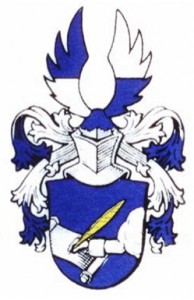
„Schreiber I“ (ca. 1760)
Yet, the first real Scriba coat („Scriba I“) looks similar to theirs and was used around 1750.

„Scriba I“ (ca. 1750)
Dating from 1704, we can still see a sign on the tomb of pastor Johannes Scriba (05.002.002) who lived two generations after Henricus. When Otto-Adolf visited the grave with his father in 1935 he described it as „somewhat clumsy stonemasonry, which clearly shows a hand with a quill next to the Hausmarke“.
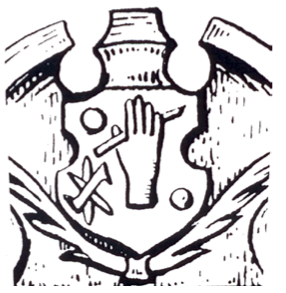
Tomb of Johannes Scriba (1704)
In 1730, the mayor of Korbach, Johannes Scriba [1673-1738 (06.001.004)] used yet another seal. The name is misspelled as „SCHRIBA“ which was probably due to an error of the craftsman who was confused by the pronunciation. In the seal we can see, as a crest, the arm holding a quill.
The lower part shows the ink well with two quills (which are not crossed).

Seal of the mayor of Korbach (1730)
An important source of information is volume two of the „Waldeckischen Wappenkunde“ which was published by the Waldeck historic society listing all the coat of arms used by commoners in the state of Hesse. Here, the Korbach coat reappears. This time, the coat is depicted in black with a silver ink well holding two silver quills. On the helmet we see a black arm with another silver quill.
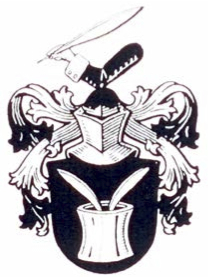
Coat with inkwell
In the middle of the 18th century (1762) we find our coat on the tombstone of pastor and superintendent Johann Christoph Scriba (07.010.025) set into the wall of the church in Nieder Beerbach. Located under two crossed quills we find the writing arm with quill, again. A hand with quill is also used as a crest. This time, it‘s a left arm, probably chosen for the sake of symmetry as the coat of his wife‘s family is depicted on the right of the stone. Both crests lean towards each other.
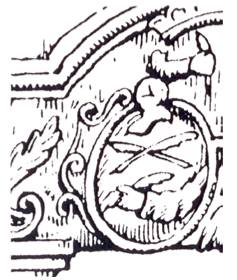
Tomb of Johann Chr. Scriba (1762)
In 1801, Heinrich Daniel Schreiber (1746-1816) used a similar seal. He is a son of clergyman and land owner Johannes Schreiber of Adorf. We don‘t have proof of this family being part of our ancestry, yet, but it seems rather likely to me, as he was also married to a member of the Loofs-family, just like our cousin Karl Friedrich Burchard Scriba [1734-1798, (07.036.051)]. The silver coat shows a black writing arm reaching down from a silver cloud in the upper right corner.
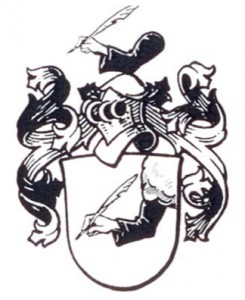
Coat of Heinrich D. Schreiber (1801)
The two best-known coats of arms first appear side by side on the title page of our genealogy written in 1824 by Eduard Scriba (D10.018.027). The original print is even colored. We don‘t know how Eduard obtained those drawings. Unfortunately, all documents used by Eduard (such as the records by Varnhagen) which had been collected before World War II were lost when the Darmstadt castle was devastated by fire during the war. Along with the city archive the fire destroyed the complete collection of documents the Scriba family had compiled up to that point.
The coats of 1824 show crowns, which were inappropriate for a family which didn‘t have aristocratic ancestry. The crosiers were also newly added. They obviously allude to the long line of clergyman in the family (although, strictly speaking, no Scriba ever made it to bishop). Who came up with the crosiers is unclear. Once more, they remind us that the details of the coat have varied quite a bit over time.
The Waldeck-almanach shows slightly dif- ferent versions of our coat used at the time.

Coats from the 19th century
Finally, Otfried Praetorius (D 10.017.13.321) and Hermann Scriba (D 12.030.022) set out around 1950 to have the different versions consolidated by a specialist in heraldry. The „new“ coat was obviously inspired by the early „Scriba I“ version and the crosier-variation of 1824. The aristocratic symbols, which had been sneaked in, were removed. Instead of the crown the helm now has a torse. The writing arm as well as the escutcheon is now slightly inclined.

Printing plate and print of the current coat (from ca. 1950)
The original coat of the aristocratic cousins of the Laurentius-line has also been found a short while ago.

Coat of the Laurentiusline
By the way, these days any family can invent and register a coat of arms. Coats are protected similar to logos but do not grant any kind of exclusivity. So, in principle, any Scriba family could come up with their own coat, but after several centuries of development I think we can be quite happy with the one we have.